|
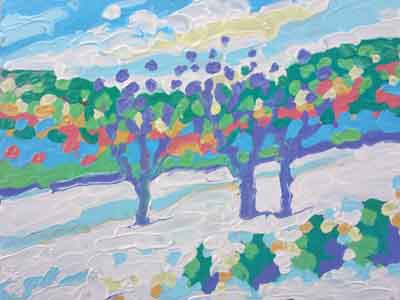
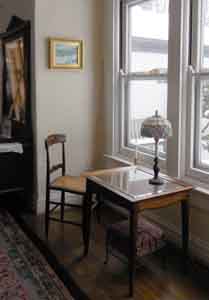
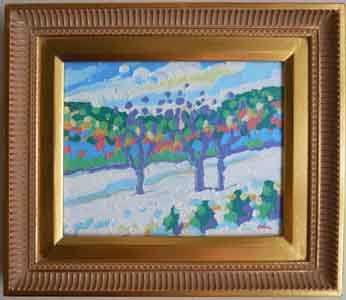
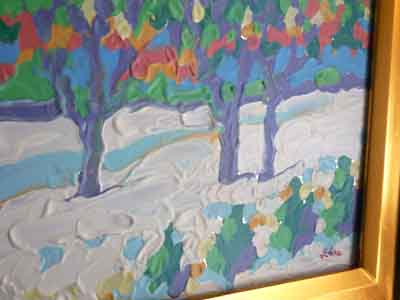
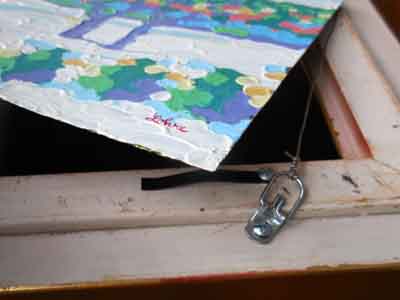
Perfect
North Slopes III, Finished Tuesday, January 6, 2015, 8" x 10"
x .016” x 2 oz., Oil
pastel on melted on shiny duct metal. Framed in a Neapolitan style
simulated gold leaf over clay over wood with no seam in corners weighing
2.5 pounds
After a terrible fall on the slope March 15, 2014, Tom retired from skiing
for the foreseeable future. His knee replacement has regulated him to
the job of reading books, sitting by the fire, gazing out the windows,
kitting or painting in Tom’s case while his daughter skies. The
funny thing about panting is that he needed a power outlet to run the
heat gun he uses to heat up the metal to melt the Sakura oil pastels.
Turned out that he was shorting out the sockets in the lodge till he found
one that worked. This work shows the old leaves in the forest along the
edges of the snow. Occasionally a line of trees pops up between runs still
stripped of all life. In the foreground a line of pine trees separate
the run from a gully.
Finished Tuesday, January 6, 2015, 8" x 10" x .016” x
2 oz., Oil pastel on melted on shiny duct metal. Framed in a Neapolitan
style simulated gold leaf over clay over wood with no seam in corners
weighing 2.5 pounds. Can be shipped in a box 20” x 14” x 4”
weighing 3.5 pounds. Work can be purchase without the frame shipped in
15" x 12" x 4" box weighing 2 pounds. Shipping is not free
as listed in shipping. Packing and shipping fees to be determined. Painting
can be picked up in Cincinnati for free or delivered by the artist within
a two hundred mile radius for a determined fee.
These colorful artworks are painted with blobs. Tom’s blob painting
started in 1980 when Tom explored the possibility of a machine that painted.
He was painting impressionistic works one right after another and thought
he could make a machine to do this. In 2003 he discovered Lego MindStorm
Invention System and spent four years learning the software. On January
5th, 2007 at 9 p.m. he cracked the code to write a program that took information
from an image in the computer and fed it to a painting machine. The painting
machine was a classical assistant. It laid one of eight colors in generally
the correct spot.
The painting machine needed a great stroke to be successful. Tom cannot
remember the exact time he thought of melting wax on hot metal to make
a stroke. It was a beautiful stroke with a velvety surface and heavy impasto.
Sakura oil pastels are melted and mixed into a certain color in a dish
on a hot plate then sucked into a brass tube, cooled and extruded. The
Lego MindStorm Invention System painting machine did ten works. The next
painting machine will surf the Web for a paintable image then paint it.
Now Tom uses the technique for his impressionist paintings. The painting
is reduces the motif to nine colors in various blob shapes. Like color
printing reducing realism into four colors he reduced realism to nine
colors. Each of the nine colors selected set off an alarm in Tom’s
head. After numerous attempts to expand or improve the color set he has
not found the next formula. These colors are so important they need introductions.
First is white for obvious reasons playing the first in the gray scale,
second is light yellow to be the next in the gray scale. All nine colors
act as an incremental step through the gray scale. When photographed with
a black and white camera the colors act as clear steps from white to a
value nine. There is no color darker than a value nine because it keeps
the painting vibrant. Darker colors pull the painting down emotionally.
The light yellow highlights the face, creates the sun glinted land and
acts as the yellow in clouds. Third is light blue playing a major role
for sky and light shadow. Fourth is light green holding down the role
of young growth and early shadow in the face. Fifth is yellow ochre is
the third gray scale in the face as well as burnt grass and light wood.
Sixth is Nantucket red is the fourth color in the face gray scale and
if unique being the only red in the palette. It is blood, bramble and
dark wood. Seventh is dark blue the third gray scale for the sky, early
shadow for the face, periwinkle for clothes and reflections for water.
Eighth is dark violet the first definer of cool shadow, black, hair and
deep sky. Ninth is dark evergreen for deepest close shadow, black, dense
growth and hair. It is hard to believe that with just these colors you
can create full color and exact realism if you stand far enough away from
the canvas. Once up close the painting becomes a bouquet of flowers.
Tom applies the special palette in various forms, oil paint, acrylic
and melting fancy crayons on metal. Derived from his painting machine,
melting oil pastels on hot metal took numerous steps. After retiring the
painting machine that used the technique he adapted it for painting in
hotel rooms since you could paint a lively impasto impressionist work
without smell. At first he heated plastic sheets of Lexan on a hot plate.
Through a mishap the sheet of ceramic he laid on top of a hot plate to
heat the plastic evenly broke and he came back to a five foot blue flame.
Freaked out since he was preforming this exhibition in a public theater
he came to his senses and carefully picked up the hot plate and carried
it outside. It is a miracle the smoke alarms did not go off. The plastic
burned with such rocket nozzle purity he took it to be an omen.
Eventually he discovered you could heat up the metal with a hot air gun
used to melt paint or a kitchen butane torch by heating the surface from
the front, heating without moving the canvas. The painting machine heated
the metal from behind and he developed three variations using hot plates
and electric pancake skillets with magnets embedded in it to hold the
metal. It was a nuisance to move the metal to the heated area since heating
the whole surface for a long time deteriorated the wax pigment. Now the
only restriction to larger works was the weight of the metal, a four by
three foot piece of 28 gauge flashing metal weights fifteen pounds. Tom
is currently cutting canvases off a three by fifty foot roll of roof flashing
metal. Earlier he used aluminum. The shiny surface made an alluring addition
to the canvas since it reflects light at the proper angle from the small
spots not covered by pigment. The future is shinny aluminum cut from four
by eight sheets.
Painting with blobs is reality. Composition and time of day establishes
the painting. This new manner cannot change the situation. The gross manner
lends itself to familiarity. The visceral manner guided by natural illustration
makes everyone there. Each stroke takes on more significance. Reality
reduced to something a printer would do but when the artist reduces the
scene to a few blobs that still have the scene then now that’s painting.
Each round edged blob means more. The blob represents the reality of painting
in the classical manner. Strike while the iron is hot. Why do anything
unless you are ready? The same is true with painting.
Shown at:
Clifton Cultural Art Center
3711 Clifton Ave; Cincinnati, OH, 45220
Opening 7 - 9 p.m. Friday, March 6, 2015; Closing Friday, April 3, 2015
Brief History of the Artist/Scientist
Tom Lohre learned by living with a master portrait painter R_. Searching
for new subjects, he painted the eruption of Mount Saint Helens while
it erupted from life, twenty miles to the south on Tum Tum Mountain. He
also painted the first space shuttle from life, 200 'feet from it, under
armed guard, the day before to took off. Besides painting portraits, Tom
paints scenes from life.
Other rights and obligations between the artist and owner of the physical
part of the artwork outlined in the Receipt of the Artworks Physical Part
listed at http://tomlohre.com/contract1.htm. For any restoration and repair
work, please call the artist, Thomas George Lohre, Jr., 513-236-1704,
tom@tomlohre.com
Tom invented this painting technique. Tom melts oil pastels on metal
by heating the metal. Once cooled the work will stay in place unless heated
to 255 degrees, at 155 degrees you can manipulate the oil pastel without
having the oil pastel move towards gravity. Run warm water over to clean,
do not rub or brush, let dry and replace in frame. Do not touch the surface.
The work should last for hundreds if not thousands of years if undisturbed
not heated above 175 F and lit by indirect light.
Send an e-mail to be added to the database as the owner.
Sign up for timely notices of new work and shows by sending an e-mail
to newart-subscribe at tomlohre.com
All information believed correct but cannot be guaranteed.
|


 Perfect North Slopes III
Lawrenceburg Indiana Cincinnati Ohio Impressionism Oil Painting by Local
Artist Tom Lohre
Perfect North Slopes III
Lawrenceburg Indiana Cincinnati Ohio Impressionism Oil Painting by Local
Artist Tom Lohre